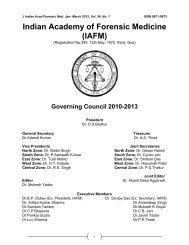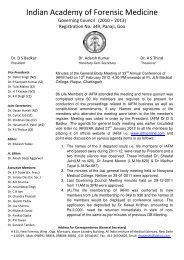Journal of Indian Academy of Forensic Medicine (JIAFM)
Journal of Indian Academy of Forensic Medicine (JIAFM)
Journal of Indian Academy of Forensic Medicine (JIAFM)
Create successful ePaper yourself
Turn your PDF publications into a flip-book with our unique Google optimized e-Paper software.
passage <strong>of</strong> electric current, thus producing no visible<br />
electric burn mark, at the site <strong>of</strong> contact.<br />
One person was found to have consumed alcohol. It<br />
is well known that consumption <strong>of</strong> alcohol and<br />
cosequent intoxication had adverse effects, in form<br />
<strong>of</strong> motor incoordination, increased reaction time and<br />
improper judgement[6].<br />
The pathognomonic features <strong>of</strong> electrocution are the<br />
electric marks and joule burn when low or mediumvoltage<br />
current is involved. Electric marks are not<br />
always obvious especially on the hands <strong>of</strong> manual<br />
workers. Pro<strong>of</strong> <strong>of</strong> an electric mark is obtained by<br />
histological and histochemical examination[7]. In this<br />
context, we had found that histological examination<br />
could be an important aid in diagnosis <strong>of</strong><br />
electrocution, as observed in 87.23% <strong>of</strong> cases;<br />
where the findings were suggestive <strong>of</strong> electrical<br />
injuries. Of these changes, the most common<br />
findings were nucleus streaming (48.78%), dermoepidermal<br />
junction separation (48.78%) and<br />
coagulative necrosis (36.58%). Electrical injuries<br />
frequently represent high temperature burns and this<br />
produces characteristic findings <strong>of</strong> severe thermal<br />
denaturation <strong>of</strong> collagen causing it to stain blue with<br />
hematoxylin. The epidermis is <strong>of</strong>ten separated and<br />
elevated with micro-blisters within the squamous<br />
epithelium as well as in the horny layer. Nuclei <strong>of</strong><br />
epidermal cell at the site <strong>of</strong> an electrical burn<br />
frequently show stretching and narrowing <strong>of</strong> the<br />
contour to produce a palisade- type <strong>of</strong> appearance.<br />
This change is <strong>of</strong>ten referred to as streaming <strong>of</strong> the<br />
nuclei[9]. However, Schaffner (1965), who had found<br />
similar appearances were caused by cold observed<br />
elongation <strong>of</strong> the cells in the stratum germinatorum<br />
and stratum basalis[7]. Moreover, presence <strong>of</strong><br />
associated features can rule out the possibility<br />
expressed by Schaffner.<br />
Conclusion:<br />
Though fatalities caused by electricity are<br />
preventable, still deaths due to electrocution are on<br />
rise. In the present study, we had noted that majority<br />
<strong>of</strong> fatalities (97.67%) are accidental in nature<br />
whereas homicide accounted for small number<br />
(2.32%) <strong>of</strong> cases. Moreover, accidental deaths were<br />
more common in young age (35.71%) and men were<br />
found to be more vulnerable. In 45.34 % <strong>of</strong> deaths,<br />
electric contact was noted, in 31.39% contact and<br />
heat was noted. 9.30 % <strong>of</strong> cases had flash burns<br />
and in [6] cases no electric marks were found. From<br />
the present study we conclude that histological<br />
examination <strong>of</strong>fers an important aid in diagnosis <strong>of</strong><br />
electrical injuries.<br />
52<br />
<strong>JIAFM</strong>, 2007 29 (2) ISSN: 0971-0973<br />
Table No.2<br />
(Showing incidence in various age group in<br />
accidental cases)<br />
Year Male Female Total %<br />
0--10 01 01 02 2.38<br />
11--20 10 03 13 15.47<br />
21--30 25 05 30 35.71<br />
31--40 20 04 24 28.57<br />
41--50 10 01 11 13.09<br />
51--60 02 01 03 3.57<br />
61--70 01 00 01 1.19<br />
Total 69 15 84<br />
Table No.3<br />
(Showing occupation and number <strong>of</strong> cases)<br />
Occupation Cases %<br />
Business 03 3.48<br />
Electrician<br />
15 17.44<br />
Farmer 12 13.95<br />
House wife 09 10.46<br />
Laborer 18 20.93<br />
None 11 12.79<br />
Service 10<br />
11.62<br />
Student 08 9.30<br />
Total 86<br />
Table No.4<br />
(Showing histopathological findings and<br />
percentage <strong>of</strong> cases)<br />
Findings %<br />
Degeneration <strong>of</strong> collagen<br />
in dermis with coagulative<br />
necrosis<br />
36.58<br />
Degenerative changes in 2.43<br />
keratin layer<br />
Dermo-epidermal separation 48.78<br />
Hyperkeratosis 9.75<br />
Microvesicle formation 4.87<br />
Nucleus streaming 48.78<br />
Pyknoses <strong>of</strong> nuclei 17.07









